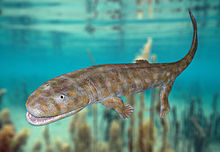Acanthostega
Acanthostega (from Ancient Greek άκανθα akantha, German 'thorn, spine' and στέγη stege 'cover, covering') is an extinct genus of vertebrate (Vertebrata) that belongs to the phylum of terrestrial vertebrates (Tetrapoda), but spent its entire life in water. Acanthostega is of special importance for evolutionary biology, because as a mosaic form it is close to the origin of the tetrapods. Only the type species A. gunnari, whose fossil was found in 1933 in 365 million year old sedimentary rocks from the Upper Devonian period in Greenland, has been scientifically described so far.
The anatomy of its fore- and hindquarters proves that the typical four limbs of land vertebrates must have already developed in the water. The still widespread assumption that land vertebrates evolved from coelacanths that used their muscular, tassel-like fish fins for occasional land walks is thus questionable. Rather, Acanthostega was already moving about on the aquatic plant-covered marsh floor with four leg-like limbs, much like modern lungfish do with their fleshy fins. A reconstruction of his limb bones shows that they could not have supported the heavy body on land at all. Moreover, Acanthostega still breathed through gills and not lungs, so it was clearly an aquatic dweller that moved about in the water with four legs and not by flapping its fins. An analysis of the skull bones also showed that Acanthostega possibly already used a bite technique to acquire food and did not catch its prey by sucking in and out, like fish living in the water.

Lifelike model of Acanthostega
Questions and Answers
Q: What is Acanthostega?
A: Acanthostega is an extinct fishapod.
Q: What is the meaning of Acanthostega?
A: Acanthostega means 'spiny roof'.
Q: When did Acanthostega appear?
A: Acanthostega appeared in the Upper Devonian about 365 million years ago.
Q: What does Acanthostega represent in vertebrate evolution?
A: Acanthostega represents one of the first vertebrates to have recognizable limbs.
Q: What is the anatomical position of Acanthostega in the evolution of lobe-finned fishes and tetrapods?
A: Acanthostega was anatomically intermediate between lobe-finned fishes and the first tetrapods fully capable of coming onto land.
Q: How many years ago did Acanthostega appear?
A: Acanthostega appeared about 365 million years ago.
Q: What is the significance of Acanthostega in evolutionary biology?
A: Acanthostega is significant in evolutionary biology because it represents an important step in the transition from water to land for vertebrates.
Search within the encyclopedia